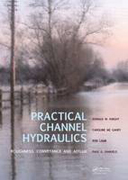
Practical channel hydraulics: roughness, conveyance and afflux
Knight, Donald W.
Gahey, Caroline Mc.
Lamb, Rob
Samuels, Paul G.
A practical guide for river engineers on key issues that are generally required when modelling flow in rivers: roughness, conveyance capacity, bridge afflux, uncertainty and floodplain hydraulics. INDICE: Forword Chapter 1 -- Introduction 1.1 Why is it needed? 1.2 Originof the CES/AES 1.3 Scope of book Chapter 2 -- Practical issues in channel hydraulics 2.1 Common difficulties in modelling flow in watercourses 2.2 Flow in simple engineered channels 2.3 Inbank flow in natural rivers 2.4 Overbank flowin natural and engineered rivers 2.5 Flows through bridges and hydraulic structures 2.6 Data sources and uses in this book Chapter 3 -- Understanding roughness, conveyance and afflux or Scientific issues -- roughness, conveyance and afflux 3.1 Concepts and flow structures 3.2 Governing equations (incl. limitations of the methods) 3.2.1 Roughness Advisor (RA) and roughness estimation methods 3.2.2 Conveyance Estimation System (CES) methods 3.2.3 Backwater calculation 3.2.4 Afflux Estimation System (AES) methods 3.3 Dealing with uncertainty 3.4 The CES/AES software (incl. limitations of the software) 3.4.1 Introduction to the RA (Roughness Advisor) 3.4.2 Introduction to the CES (Conveyance Estimation System - incl. uncertainty) 3.4.3 Introduction to the backwater module 3.4.4 Introduction to the AES (Afflux Estimation System) Chapter 4 -- Practical issues - roughness, conveyance and afflux 4.1 Estimating and using stage-discharge relationships 4.2 Estimating and using the lateral distribution of velocities and boundary shear stress 4.3 Use of backwater module 4.4 Estimating afflux at bridges and culverts 4.5 Dealing with vegetation and maintenance of weedy rivers Chapter 5 -- Further issues 5.1 Updated text on modelling, schematisation, flow structures 5.2 Dealing with ecological issues and habitats 5.2 Dealing with sediment and geo-morphological issues 5.3 Dealing with trash screens or other AES related items 5.4 Software -- where it fits in with 1D, 2D, 3D modelling 5.5 Software -- high-level flow charts -- where future updates mightfit into overall software and data flows 5.6 How to run and adapt the code - flow charts Chapter 6 -- Concluding comments
- ISBN: 978-0-415-54974-5
- Editorial: CRC Press
- Encuadernacion: Cartoné
- Páginas: 354
- Fecha Publicación: 01/01/2010
- Nº Volúmenes: 1
- Idioma: Inglés
